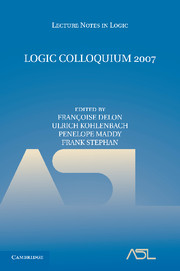Book contents
- Frontmatter
- Contents
- Introduction
- Speakers and Titles
- Decorated linear order types and the theory of concatenation
- Cardinal preserving elementary embeddings
- Proof interpretations and majorizability
- Proof mining in practice
- Cardinal structure under AD
- Three lectures on automatic structures
- Pillay's conjecture and its solution—a survey
- Proof theory and meaning: On the context of deducibility
- Bounded super real closed rings
- Analytic combinatorics of the transfinite: A unifying Tauberian perspective
- References
Analytic combinatorics of the transfinite: A unifying Tauberian perspective
Published online by Cambridge University Press: 01 March 2011
- Frontmatter
- Contents
- Introduction
- Speakers and Titles
- Decorated linear order types and the theory of concatenation
- Cardinal preserving elementary embeddings
- Proof interpretations and majorizability
- Proof mining in practice
- Cardinal structure under AD
- Three lectures on automatic structures
- Pillay's conjecture and its solution—a survey
- Proof theory and meaning: On the context of deducibility
- Bounded super real closed rings
- Analytic combinatorics of the transfinite: A unifying Tauberian perspective
- References
Summary
Abstract. From a Tauberian perspective we prove and survey several results about the analytic combinatorics of (transfinite) proof-theoretic ordinals. In particular we show how certain theorems of Petrogradsky, Karamata, Kohlbecker, Parameswaran, and Wagner can be used to give a unified treatment of asymptotics for count functions for ordinals. This uniform approach indicates that (Tauberian theorems for) Laplace transforms provide a general tool to establish connections between additive and multiplicative results and may therefore be seen as a contribution to Problem 12.21 in Burris's book on number theoretic density and logical limit laws. In the last section we give applications and prove in some detail phase transitions related to Friedman style combinatorial well-orderdness principles for fragments of first order Peano arithmetic.
Introduction to the transfinite combinatorics of the transfinite. Some years ago the author had a discussion with another logician about which fields in mathematics are surely have no connection with each other. A suggestion was: The theory of transfinite ordinal numbers and complex analysis. Of course this seems a safe guess since it is difficult to imagine that Cauchy's integral formula has something to say about the ordinals below ωω or below ∈0.
It has therefore been surprising that those connections exist and give rise to interesting cross-disciplinary applications. Perhaps even more interestingly we apply in this paper results from a paper in Lie-algebra theory to questions in logic.
- Type
- Chapter
- Information
- Logic Colloquium 2007 , pp. 238 - 267Publisher: Cambridge University PressPrint publication year: 2010



